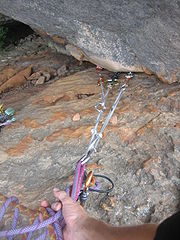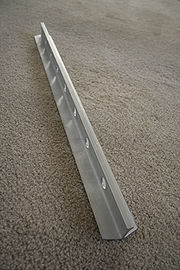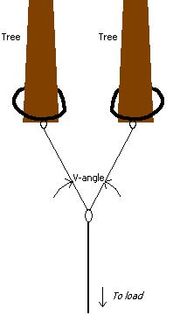.gif)
Anchor (climbing)
Encyclopedia
In rock climbing
, an anchor can be any way of attaching the climber, the rope, or a load to rock, ice, steep dirt, or a building by either permanent or temporary means. The goal of an anchor depends on the type of climbing under consideration but usually consists of stopping a fall, or holding a static load.

 Depending on the material being climbed, there are many types of protection
Depending on the material being climbed, there are many types of protection
that can be used to construct the anchor, including natural protection such as boulders and trees, or artificial protection such as cams, nuts
, bolts
or piton
s.
, steel expansion bolts, piton
s, etc.
. The leader and follower climb simultaneously with protection placed in between. When the two climbers advance using a running belay, the belay is almost as secure as using a belay device and anchors because if the leader falls, all the slack is already out of the rope and the second is the counterweight to catch the fall. A running belay is used when the risk of using the slow process of pitch climbing is greater than the consequences and/or likelihood of a leader fall.
in mountaineering
. It is driven into the snow and used to arrest falls. Snow pickets can also be placed horizontally in snow (deadman style) which provides a much more secure anchor to abseil on. Ice screws
can be hand-driven into solid ice and are the equivalent of cams or nuts when ice climbing
. Ice can also be protected using an Abalakov thread
or v-thread. Because of the uncertain holding power of ice protection, it is sometimes clipped into the rope using a load-absorbing sling or quickdraw, designed to reduce the load on protection by extending in case of a fall.
It is essential that the belayer is attached to the anchor via the belay loop at the front of the harness. Attaching the belayers harness to the anchor via the back of the harness can cause the harness, when placed under strain, to constrict inwards elongating front to back, rather than side to side. This can result in crushed pelvis and serious harm to the belayer.
 Anchor equalization is the process of combining two or more anchors in the build of a single equalized anchor. This is the method used in a redundant belay anchor, as mentioned above. If assembled correctly, the load can be distributed amongst the individual anchors, rather than placing all the load on a single anchor point. This decreases the chance that any of the anchor points will fail, and, if a point does fail, the other(s) should still be able to hold.
Anchor equalization is the process of combining two or more anchors in the build of a single equalized anchor. This is the method used in a redundant belay anchor, as mentioned above. If assembled correctly, the load can be distributed amongst the individual anchors, rather than placing all the load on a single anchor point. This decreases the chance that any of the anchor points will fail, and, if a point does fail, the other(s) should still be able to hold.
When forming an equalized anchor, it is important to take into consideration the angle formed between the two pieces of protection -- the "V-angle". One must try to minimize this angle as much as possible, because the greater the V-angle, the more force will be placed on each piece of protection.
As shown below, if the V-angle is greater than 120 degrees, the load on each anchor comprising the equalized anchor will actually be greater than the load on the rope connected to the equalized anchor. This is a hazardous situation which makes it worse to use equalization than not at all, and should be avoided.
If the load force (To load in the image at right) is and the V-angle is
and the V-angle is  , then the force on each anchor is given by:
, then the force on each anchor is given by:
 .
.
Resulting from this expression, we can deduce:
Rock climbing
Rock climbing also lightly called 'The Gravity Game', is a sport in which participants climb up, down or across natural rock formations or artificial rock walls. The goal is to reach the summit of a formation or the endpoint of a pre-defined route without falling...
, an anchor can be any way of attaching the climber, the rope, or a load to rock, ice, steep dirt, or a building by either permanent or temporary means. The goal of an anchor depends on the type of climbing under consideration but usually consists of stopping a fall, or holding a static load.
Types of anchors


Protection (climbing)
To make climbing as safe as possible, most climbers use protection, a term used to describe the equipment used to prevent injury to themselves and others.-Types of climbing:...
that can be used to construct the anchor, including natural protection such as boulders and trees, or artificial protection such as cams, nuts
Nut (climbing)
In rock climbing, a nut is a metal wedge threaded on a wire, used for protection by wedging it into a crack in the rock. Quickdraws are clipped to the nut wire by the ascending climber and the rope threads through the quickdraw. Nuts come in a variety of sizes and styles, and several different...
, bolts
Bolt (climbing)
In rock climbing, a bolt is a permanent anchor fixed into a hole drilled in the rock as a form of protection. Most bolts are either self-anchoring expansion bolts or fixed in place with liquid resin....
or piton
Piton
In climbing, a piton is a metal spike that is driven into a crack or seam in the rock with a hammer, and which acts as an anchor to protect the climber against the consequences of a fall, or to assist progress in aid climbing...
s.
Natural anchor
A natural anchor is one that does not require man-made climbing gear. Such anchors may consist of trees, chockstones already lodged in a crack, horns and protrusions, etc.Artificial anchor
An artificial anchor consists of man-made climbing gear placed in the rock. Such gear may be spring-loaded camming devices, aluminum chockstonesNut (climbing)
In rock climbing, a nut is a metal wedge threaded on a wire, used for protection by wedging it into a crack in the rock. Quickdraws are clipped to the nut wire by the ascending climber and the rope threads through the quickdraw. Nuts come in a variety of sizes and styles, and several different...
, steel expansion bolts, piton
Piton
In climbing, a piton is a metal spike that is driven into a crack or seam in the rock with a hammer, and which acts as an anchor to protect the climber against the consequences of a fall, or to assist progress in aid climbing...
s, etc.
Belay anchor
A belay anchor is used as a sole attachment to the cliff face, to support a belay or toprope. Ideally, it should consist of multiple redundant components (natural and/or artificial), none of which are likely to fail, and none of which in the event of failure would cause the entire anchor to fail. Any one component of a good anchor should be able to support the entire system by itself. If these conditions are met, the system will be essentially bombproof.Running belay anchor
A running belay anchor is used as a safeguard in the event of a fall while lead climbingLead climbing
Lead climbing is a climbing technique used to ascend a route. This technique is predominantly used in rock climbing and involves a lead climber attaching themselves to a length of dynamic climbing rope and ascending a route while periodically attaching protection to the face of the route and...
. The leader and follower climb simultaneously with protection placed in between. When the two climbers advance using a running belay, the belay is almost as secure as using a belay device and anchors because if the leader falls, all the slack is already out of the rope and the second is the counterweight to catch the fall. A running belay is used when the risk of using the slow process of pitch climbing is greater than the consequences and/or likelihood of a leader fall.
Ice anchors
The snow picket is used as an anchorAnchor
An anchor is a device, normally made of metal, that is used to connect a vessel to the bed of a body of water to prevent the vessel from drifting due to wind or current. The word derives from Latin ancora, which itself comes from the Greek ἄγκυρα .Anchors can either be temporary or permanent...
in mountaineering
Mountaineering
Mountaineering or mountain climbing is the sport, hobby or profession of hiking, skiing, and climbing mountains. While mountaineering began as attempts to reach the highest point of unclimbed mountains it has branched into specialisations that address different aspects of the mountain and consists...
. It is driven into the snow and used to arrest falls. Snow pickets can also be placed horizontally in snow (deadman style) which provides a much more secure anchor to abseil on. Ice screws
Ice screw
An ice screw is a threaded tubular screw used as a running belay or anchor by climbers on steep ice surface such as steep waterfall ice or alpine ice during ice climbing or crevasse rescue, to hold the climber in the event of a fall, and at belays as anchor points. Ice screws are made by...
can be hand-driven into solid ice and are the equivalent of cams or nuts when ice climbing
Ice climbing
Ice climbing, as the term indicates, is the activity of ascending inclined ice formations. Usually, ice climbing refers to roped and protected climbing of features such as icefalls, frozen waterfalls, and cliffs and rock slabs covered with ice refrozen from flows of water. For the purposes of...
. Ice can also be protected using an Abalakov thread
Abalakov thread
The Abalakov thread, or V-Thread, is an ice protection device named after its inventor, Soviet climber Vitaly Abalakov. The Abalakov thread is a common method of protecting oneself while ice climbing because it is easy to create, doesn't require the sacrifice of expensive gear, and can be very...
or v-thread. Because of the uncertain holding power of ice protection, it is sometimes clipped into the rope using a load-absorbing sling or quickdraw, designed to reduce the load on protection by extending in case of a fall.
Indirect
When the rope goes from the climber to the belayer. Most often used under controlled circumstances at climbing walls or when the climber doesn't have the weight advantage on the belayer during bottom roped climbs. It is impossible to escape from the system.Semi-direct
When the rope comes from the climber to the belayer, but the belayer is attached separately to an anchor. Often used when multi pitching and the belayer is on a stance. Or when top roping and it is possible that if the climber falls the belayer will be pulled from the stance above the climber. The belayer can, with a little effort then remove themselves from the system if required.It is essential that the belayer is attached to the anchor via the belay loop at the front of the harness. Attaching the belayers harness to the anchor via the back of the harness can cause the harness, when placed under strain, to constrict inwards elongating front to back, rather than side to side. This can result in crushed pelvis and serious harm to the belayer.
Direct
When the rope comes from the climber to an anchor. A hanging belay device may be used, although it is common in this instance to just use an Italian hitch. The belayer is totally free of the system.Equalization

When forming an equalized anchor, it is important to take into consideration the angle formed between the two pieces of protection -- the "V-angle". One must try to minimize this angle as much as possible, because the greater the V-angle, the more force will be placed on each piece of protection.
As shown below, if the V-angle is greater than 120 degrees, the load on each anchor comprising the equalized anchor will actually be greater than the load on the rope connected to the equalized anchor. This is a hazardous situation which makes it worse to use equalization than not at all, and should be avoided.
If the load force (To load in the image at right) is
 and the V-angle is
and the V-angle is  , then the force on each anchor is given by:
, then the force on each anchor is given by: .
.Resulting from this expression, we can deduce:
- At a V-angle of 30 degrees, each of the two anchors bear a force of about 52% of the original load.
- At 45 degrees, each anchor bears about 54% of the load.
- At 60 degrees, each anchor bears about 58% of the load.
- At 90 degrees, each anchor bears about 71% of the load.
- At 120 degrees, each anchor bears a force equivalent to 100% of the original load. An angle this large should never be used.

